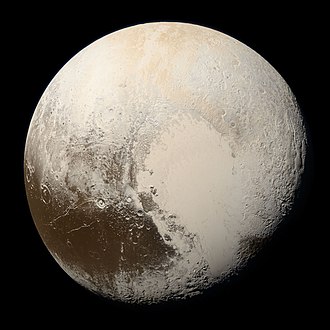Trans-Neptunian object
Trans-Neptunian objects (TNOs) are minor planets in the Solar System that orbit the Sun at a greater average distance than Neptune, the eighth and farthest known planet from the Sun. These objects reside in the Kuiper Belt, the Scattered Disc, and the Oort Cloud, which are regions filled with icy bodies and remnants from the early Solar System. The study of TNOs provides valuable insights into the formation and evolution of the Solar System, as well as the composition of the early solar nebula.
Discovery and Exploration
The first TNO, Pluto, was discovered in 1930 by Clyde Tombaugh. For many years, Pluto was considered the ninth planet of the Solar System until the discovery of similar-sized objects in the Kuiper Belt led to its reclassification as a dwarf planet in 2006. The discovery of the Kuiper Belt in the 1990s, starting with (15760) 1992 QB1, marked the beginning of the exploration of TNOs. Since then, thousands of TNOs have been identified, including notable objects like Eris, Haumea, and Makemake.
Classification
TNOs are classified into several groups based on their orbits:
- Kuiper Belt Objects (KBOs): These objects have orbits that are relatively close to the ecliptic plane and are further divided into the classical KBOs, which have more stable orbits, and the resonant KBOs, which are in orbital resonance with Neptune.
- Scattered Disc Objects (SDOs): These objects have highly elliptical and inclined orbits, suggesting they were scattered by Neptune's gravity.
- Detached Objects: Also known as extended scattered disc objects, these TNOs have orbits that are too far from Neptune to have been directly influenced by its gravity, suggesting other mechanisms for their current orbits.
- Oort Cloud Objects: Though not directly observed, these are theoretical objects believed to exist in a distant cloud surrounding the Solar System. Their existence is inferred from the long-period comets that enter the inner Solar System.
Physical Characteristics
TNOs are primarily composed of ices (such as water, methane, and ammonia) and rock. Their surfaces are often colored red due to the presence of tholins, organic compounds created by the irradiation of simpler compounds. The size of TNOs varies widely, from as small as 10 km in diameter to over 2,000 km for the largest known objects like Pluto and Eris.
Importance of Study
Studying TNOs is crucial for understanding the outer Solar System's dynamics and the distribution of small bodies beyond Neptune. These objects are considered pristine remnants from the formation of the Solar System, potentially holding clues about the early solar nebula's composition and the processes that led to the formation of planets and other solar system bodies.
Challenges in Observation
Observing TNOs poses significant challenges due to their small size, low brightness, and great distance from Earth. Advances in telescope technology and the development of specialized surveys have been crucial in identifying and studying these distant objects.
Transform your life with W8MD's budget GLP-1 injections from $125.
W8MD offers a medical weight loss program to lose weight in Philadelphia. Our physician-supervised medical weight loss provides:
- Most insurances accepted or discounted self-pay rates. We will obtain insurance prior authorizations if needed.
- Generic GLP1 weight loss injections from $125 for the starting dose.
- Also offer prescription weight loss medications including Phentermine, Qsymia, Diethylpropion, Contrave etc.
NYC weight loss doctor appointments
Start your NYC weight loss journey today at our NYC medical weight loss and Philadelphia medical weight loss clinics.
- Call 718-946-5500 to lose weight in NYC or for medical weight loss in Philadelphia 215-676-2334.
- Tags:NYC medical weight loss, Philadelphia lose weight Zepbound NYC, Budget GLP1 weight loss injections, Wegovy Philadelphia, Wegovy NYC, Philadelphia medical weight loss, Brookly weight loss and Wegovy NYC
|
WikiMD's Wellness Encyclopedia |
| Let Food Be Thy Medicine Medicine Thy Food - Hippocrates |
Medical Disclaimer: WikiMD is not a substitute for professional medical advice. The information on WikiMD is provided as an information resource only, may be incorrect, outdated or misleading, and is not to be used or relied on for any diagnostic or treatment purposes. Please consult your health care provider before making any healthcare decisions or for guidance about a specific medical condition. WikiMD expressly disclaims responsibility, and shall have no liability, for any damages, loss, injury, or liability whatsoever suffered as a result of your reliance on the information contained in this site. By visiting this site you agree to the foregoing terms and conditions, which may from time to time be changed or supplemented by WikiMD. If you do not agree to the foregoing terms and conditions, you should not enter or use this site. See full disclaimer.
Credits:Most images are courtesy of Wikimedia commons, and templates, categories Wikipedia, licensed under CC BY SA or similar.
Contributors: Prab R. Tumpati, MD






